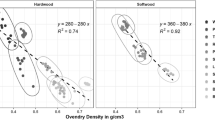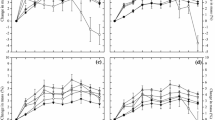Abstract
European beech wood (Fagus sylvatica L.) was modified with thermosetting phenol–formaldehyde (PF) resins, which were blended with various additives (ferric chloride and a mixture of ferric sulphate and hydrolysable tannin) to stain the material. The aim was to stain the wood dark and to enhance the moisture-related properties as well as the weathering performance. The weight percent gain (WPG) and solution uptake were only slightly influenced by the composition of the resin formulations. All treatments induced high bulking, dimensional stability and reduced the maximum swelling of the wood. Particularly at high relative humidity the equilibrium moisture content (EMC) of the modified wood was clearly reduced compared to the control. All formulations darkened the wood colour and enhanced the colour stability. The formulations containing ferric sulphate and tannin caused the darkest colour and the highest colour stability in the course of weathering. The modification with all formulations clearly reduced the capillary water uptake compared to the control. The capillary water uptake increased due to weathering. The increase was highest with the control, followed by the samples modified with tannin formulations and those containing only PF as sole phenol component. It is concluded that addition of iron salt as well as tannin can be used to stain the wood dark without negatively affecting the effects of modification with PF resin.





Similar content being viewed by others
References
DIN EN 927-6 (2006) Paints and varnishes—Coating materials and coating systems for exterior wood—Part 6: Exposure of wood coatings to artificial weathering using fluorescent UV lamps and water. European committee for standardisation, Brussels, Belgium
DIN EN ISO 15148 (2003) Hygrothermal performance of building materials and products—determination of water absorption coefficient by partial immersion. European committee for standardisation, Brussels, Belgium
EN 84 (1997) Wood preservatives. Accelerated ageing of treated wood prior to biological testing—leaching procedure. European committee for standardisation, Brussels, Belgium
Evans PD, Gibson SK, Cullis I, Liu CL, Sèbe G (2013) Photo-stabilization of wood using low molecular weight phenol formaldehyde resin and hindered amine light stabilizer. Polym Degrad Stabil 98(1):158–168
Furuno T, Imamura Y, Kajita H (2004) The modification of wood by treatment with low molecular weight phenol-formaldehyde resin: a properties enhancement with neutralized phenolic-resin and resin penetration into wood cell walls. Wood Sci Technol 37(5):349–361
Ghosh SC, Militz H, Mai C (2009) The efficacy of commercial silicones against blue stain and mould fungi in wood. Eur J Wood Prod 67:159–167
Himmel S, Mai C (2014) Effects of acetylation and formalization on dynamic water vapour sorption behaviour of wood. Holzforschung 69(5):633–643
Hosseinpourpia R, Adamopoulos S, Mai C (2016) Dynamic vapour sorption of wood and holocellulose modified with thermosetting resins. Wood Sci Technol 50(1):165–178
Hynes MJ, O’Coinceanainn M (2001) The kinetics and mechanisms of the reaction of iron(III) with gallic acid, gallic acid methyl ester and catechin. J Inorg Biochem 85:131–142
Jaen JA, Gonzalez L, Vargas A, Olave G (2003) Gallic acid, ellagic acid and pyrogallol reaction with metallic iron. Hyperfine Interact 148/149:227–235
Kainins MA (1966) Surface characteristies of wood as they affect durability of finishes: photochemical degradation of wood. US FS res paper FPI 57:23–60
Khanbabaee K, van Ree T (2001) Tannins: classification and definition. Nat Prod Rep 18:641–649
Kielmann BC, Mai C (2016a) Application and artificial weathering performance of translucent coatings on resin-treated and dye-stained beech-wood. Prog org coat 95:54–63
Kielmann BC, Mai C (2016b) Natural weathering performance and the effect of light-stabilizers in water-based coating formulations on resin-modified and dye-stained beech-wood. J Coat Technol Res 13(6):1065–1074
Kielmann BC, Militz H, Adamopoulos S (2012) Combined N-methylol melamine colouring agent modification of hardwoods to improve their performance under use class 3. In: Proceedings 6th European Conference on Wood Modification, Slovenia, pp 437–446
Kielmann BC, Adamopoulos S, Militz H, Koch G, Mai C (2013a) Modification of three hardwoods with an N-methylol melamine compound and a metal-complex dye. Wood Sci Technol 48(1):123–136
Kielmann BC, Adamopoulos S, Militz H, Mai C (2013b) Strength changes in ash, beech and maple wood modified with a N-methylol melamine compound and a metal-complex dye. Wood Res 58(3):343–350
Kielmann BC, Adamopoulos S, Militz H, Mai C (2014) Decay resistance of ash, beech and maple wood modified with N-methylol melamine and a metal complex dye. Int Biodeter Biodegr 89:110–114
Klüppel A, Mai C (2013) The influence of curing conditions on the chemical distribution in wood modified with thermosetting resins. Wood Sci Technol 47:643–658
Krekel C (1999) The chemistry of historical iron gall inks. Int J Forensic Doc Exam 5:54–58
Marmolle F, Leize E, Mila I, Van Dorsselaer A, Scalbert A, Albrecht-Gary AM (1997) Polyphenol metallic complexes: characterization by electrospray mass spectrometric and spectrophotometric methods. Analusis 25(8):53–55
Morawetz H. (1949) Phenolic antioxidants for paraffinic materials. Ind Eng Chem 41(7):1442–1447
Neevel JG (1995) Phytate: a potential conservation agent for the treatment of ink corrosion caused by irongall inks. Restaurator 16:143–160
O’Connor D, Richards A (1999) The right mud: studies in mud-tannic dyeing in west china and west surrey. In Kirby J (ed) Dyes in history and archaeology 18, Archetype, Brussels, 2002, pp 41–46
Ohmae K, Minato K, Norimoto M (2002) The analysis of dimensional changes due to chemical treatments and water soaking for hinoki (Chamaecyparis obtusa) wood. Holzforschung 56(1):98–102
Rowell RM (2014) Acetylation of wood-a review. Int J of Lignocellulosic Prod 1(1):1–27
Ryu JY, Imamura Y, Takahashi M, Kajita H (1993) Effects of molecular weight and some other properties of resin on the biological resistance of phenolic resin treated wood. Mokuzai Gakkaishi 39(4):486–492
Shams MI, Yano H (2011) Compressive deformation of phenol formaldehyde (PF) resin-impregnated wood related to the molecular weight of resin. Wood Sci Technol 45(1):73–81
Sistach MC, Gibert JM, Areal R (1999) Ageing of laboratory irongall inks studied by reflectance spectrometry. Restaurator 20:151–166
Stamm AJ, Seborg RM (1936) Minimizing wood skrinkage and swelling—treatment with synthetic resin forming materials. Ind Eng Chem 28(10):1164–1169
Sudiyani Y, Takahashi M, Imamura Y, Minato K (1999) Physical and biological properties of chemically modified wood before and after weathering. Wood Res Bull Wood Res Inst Kyoto Univ 86(1):1–6
Sudiyani Y, Ryu JY, Hattori N, Imamura Y (2001) Phenolic resin treatment of wood for improving weathering properties. In Imamura Y (ed) High-performance utilization of wood for outdoor uses. Wood Research Inst, Kyoto Univ, pp 85–96
Sungur S, Uzar A (2008) Investigation of complexes tannic acid and myricetin with Fe(III). Spectrochim Acta A 69:225–229
Tarkow H, Southerland CF, Seborg RM (1966) Surface characteristics or wood as they affect durability of finishes. Part I. Surface stabilization. US For Serv For Prod Lab Rpt 57:1–22
Wilson H, Carr C, Hacke M (2012) Production and validation of model iron-tannate dyed textiles for use as historic textile substitutes in stabilisation treatment studies. Chem Cent J 6(44):1–13
Xiao Z, Xie Y, Militz H, Mai C (2010) Fffect of glutaraldehyde on water related properties of solid wood. Holzforschung 64:483–488
Xie Y, Krause A, Mai C, Militz H, Richter K, Urban K, Evans PD (2005) Weathering of wood modified with the N-methylol compound 1,3-dimethylol-4,5-dihydroxyethyleneurea. Polym Degrad Stabil 89:189–199
Xie Y, Krause A, Militz H, Turkulin H, Richter K, Mai C (2007) Effect of treatments with 1,3-dimethylol-4,5-dihydroxyethyleneurea (DMDHEU) on the tensile properties of wood. Holzforschung 61:43–50
Acknowledgements
The authors would like to thank Mr. Nikos Pargianas, NTL Chemical Consulting, Thessaloniki, Greece for supplying chemicals. We very much appreciate the support afforded by Surfactor GmbH, Schöppenstedt, Germany and Christian D. Markmann GmbH, Hamburg, Germany.
Author information
Authors and Affiliations
Corresponding author
Rights and permissions
About this article
Cite this article
Kielmann, B.C., Butter, K. & Mai, C. Modification of wood with formulations of phenolic resin and iron-tannin-complexes to improve material properties and expand colour variety. Eur. J. Wood Prod. 76, 259–267 (2018). https://doi.org/10.1007/s00107-017-1180-0
Received:
Published:
Issue Date:
DOI: https://doi.org/10.1007/s00107-017-1180-0




